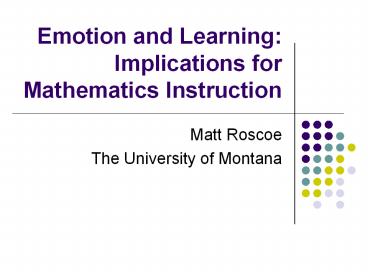Emotion and Learning: Implications for Mathematics Instruction PowerPoint PPT Presentation
1 / 25
Title: Emotion and Learning: Implications for Mathematics Instruction
1
Emotion and LearningImplications for
Mathematics Instruction
- Matt Roscoe
- The University of Montana
2
Brain Based Education
- From a cognitive perspective, learning is
explained as the building of neural connections - A familiarity of basic neural connectivity and
brain structure leads to greater understanding of
how the brain thinks, comprehends and ultimately
learns - An understanding of how the brain functions
points to brain based educational reforms
3
MacLeans Triune Brain Model
4
e-mo-tion, n.
- A mental state that arises spontaneously rather
than through conscious effort and is often
accompanied by physiological changes a feeling
the emotions of joy, sorrow, reverence, hate, and
love - A state of mental agitation or disturbance
- The part of the consciousness that involves
feeling sensibility
5
Cortex-Limbic Relationship
- Far more neural fibers project from the limbic
system to the cerebral cortex than the reverse - Emotion plays a role in focusing attention from
competing sensory input - Emotion and memory are closely linked
6
Emotion and Education
- Emotion drives attention, which drives learning,
memory and problem solving and almost everything
else we doby not exploring the role that emotion
plays in learning and memory, our profession has
fallen decades behind in devising useful
instructional procedures that incorporate and
enhance emotion. (Sylwester, 1998)
7
Mathematics Education Slope
- Standard 1 The student must be able to
calculate the slope of a line that passes through
any two points on the coordinate plane. - Standard 2 The student must differentiate
between positive/negative slope. - Standard 3 The student must understand the
meaning of slope in application problems.
8
Mathematics EducationSlope Standard Approach
- Algebraically define slope
- Calculate slope for several pairs of points
- Describe positive and negative slope
9
Mathematics EducationSlope Standard Approach
10
Mathematics EducationSlope Emotional Approach
11
Mathematics EducationSlope Emotional Approach
12
Mathematics EducationSlope Emotional Approach
13
Mathematics EducationSlope Emotional Approach
14
Mathematics EducationSlope Emotional Approach
- Interpretation Depreciation of -1,923.57 per
year - Follow Up
- Which cars might have higher/lower rates of
depreciation? Why? - Do any cars have a positive appreciation? Why?
- Will depreciation always be linear? Why?
15
Mathematics EducationLines Emotional Approach
16
Mathematics EducationLines Emotional Approach
- The price of cable television has rapidly
increased in the recent past. Mathematically
model this trend and use your model to make
several predictions regarding the future pricing
of cable television.
17
Mathematics EducationLines Emotional Approach
18
Mathematics EducationLines Emotional Approach
- Cable TV has steadily raised about 1.51 per
year. A linear model was used because when a
steady increase of something is used it is a
viable way to predict the future. The linear
model for this particular problem was y 1.508x
15.581. The model tells us that the increase
each year is about 1.51 and in 1990 the cost was
about 15.58. If you plug in x you can
predict the cost in the year 2010 the cost will
be about 45.74. - (Student Response)
19
Mathematics EducationQuadratics World
Population
- World population has been increasing rapidly in
the last century. Accurately predicting world
population is important from an economic,
political and social standpoint.
20
Mathematics EducationQuadratics World
Population
21
(No Transcript)
22
Mathematics EducationQuadratics World
Population
23
Mathematics EducationQuadratics World
Population
- I think the quadratic (y ax2 bxc) better
illustrates the world population. The past chart
shows that the population rate rises nearly a
full billion every 10 years. The quadratic form
follows this pattern more closely. Notice that
more of the points line up with the quadratics
solution. - (Student Response)
24
Mathematics EducationQuadratics World
Population
- Having an accurate count of future population
makes it possible to make predictions for what
social needs must be met in the future. It tells
us how many people will be living in a voting
district or estimated population of a city. It
can tell us how much money we will need for
social program like welfare, or how big to build
roads leading to growing rural areas. With a
linear growth model we will not have accurate
numbers for determining social, political and
economic needs. - (Student Response)
25
References / Contact Info
- Sylwester, R. (1994, October) How Emotions Affect
Learning. Educational Leadership, 52 (2), 60-65. - Greenberg, J. (1978, November) Memory Research
An Era of Good Feeling. Science News, 114
(22), 364-365. - Sylwester, R. (1998) Discover Your Brain Emotion
and Attention. How Our Brain Determines Whats
Important. Report, Retrieved February 10, 2005
from the ERIC database. - Slywester, R. (1995) A Celebration of Neurons An
Educators Guide to the Human Brain. Alexandria,
Virginia ASCD. - Caine, R.M., Caine, G.C. (1997) Education on the
Edge of Possibility. Alexandria, Virginia ASCD.
- Matt Roscoe
- University of Montana
- Missoula, MT 59812
- (406) 243-6689
- roscoem_at_mso.umt.edu

